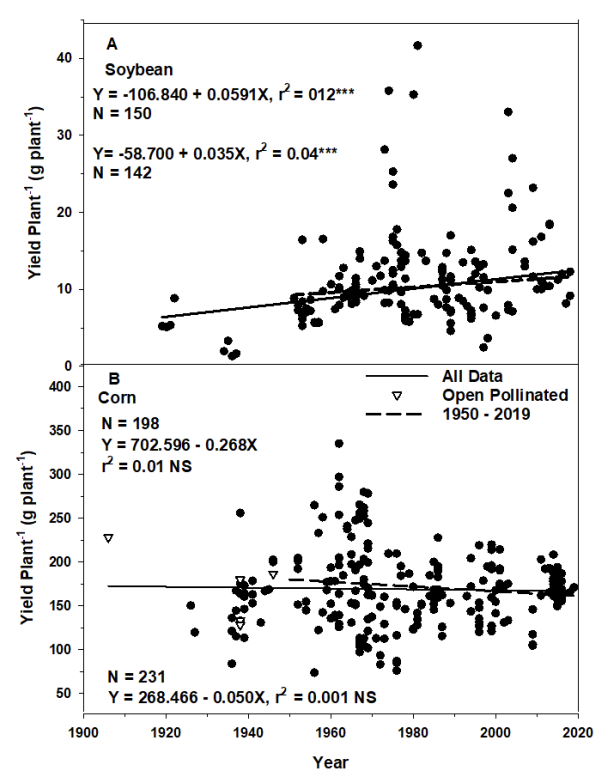Yield Improvement and Yield Components: Corn vs. Soybean
By Dr. Dennis Egli, Professor Emeritus, University of Kentucky
Corn and soybean yields have increased steadily during agriculture’s high-input era (~ 1950 to the present). The increase in yield was associated with more seeds per unit area in both crops. The higher yields are attributed to genetic improvement, better management practices, and, possibly, changes in the environment, although the contribution of each is hotly debated. There has been, however, less discussion of how the plant changed to produce more seeds per unit area.
I collected data from field experiments in the referred literature to evaluate how corn and soybean plants changed to accommodate the increase in seeds per unit area as yield increased. My data set contained 172 observations (1919 to 2018) for soybean and 231 observations (1906 to 2019) for corn with the bulk of the observations for both species occurring after 1940. Yield per plant was calculated by dividing yield by plant population.
Soybean plant population did not change from 1919 to 2018 (averaged 121,000 plants/acre), but corn population increased steadily from 6500 to 36,000 plants/acre. Yield per plant of soybean increased steadily over the interval as a result of the increasing yield and a constant population (Fig. 1A). In contrast, yield per plant for corn did not change as a result of increases in both yield and population (Fig. 1B).
Fig.1. Time trend of yield per plant of corn and soybean from the early 1900s to the present . Calculated from yield and plant population. Soybean yields greater than 20 g plant-1 were not included in the regressions. Adapted from Egli (2023).
The response of corn and soybean plants to yield improvement was completely different. The corn plant was not flexible; it did not increase yield (Fig. 1B) or kernels per plant as yield increased nearly six-fold (41 to 225 bushels/acre). The increase in seeds per acre associated with higher yield came entirely from more plants per acre. The soybean plant, on the other hand, was flexible; yield (Fig. 1A) and seeds per plant increased as yield increased from 26 to 64 bushels/acre with no change in plant population.
The increase in seeds per acre came entirely from more seeds per plant. The increase in seeds per plant for soybean could come from more nodes per plant, more flowers per node and/or a decrease in flower and pod abortion. I don’t know which components changed, but the literature suggests that flowers per node is a good candidate.
Interestingly, corn plants can also flex – they can produce more than one ear on the main stem (there are ear primordia at every node below the ear node) and they can produce ear-bearing tillers - but most modern hybrids produce only a single ear at normal populations. Apparently, flexibility was not emphasized during hybrid improvement in the U.S.
Flexibility does not seem to have anything to do with yield improvement. The relative rate (% per year) of yield increase in the U.S. is the same for corn and soybean (based on national yields reported by the National Ag Statistics Service).
Flexibility does, however, have a huge effect on crop management. Since the corn plant is not flexible, the increase in seeds per area that was associated with higher yields had to come from an increase in population. Maximum corn yields depend upon selecting the correct population which is determined by the yield level (only an approximate level is known prior to planting) and the reproductive characteristics of the hybrid [kernel size (weight per kernel or kernels per bushel) and ear size (potential kernels per ear)]. If the population is too low, yield will be limited by the number of kernels the plant can produce. Yield may also be reduced if the population is too high.
One important implication of the dependence of corn yield on population is that the higher yields of the future will require rows narrower than 30 inches to accommodate the higher populations that will be needed. After all, there is a limit to how many plants can be grown in a foot of a 30-inch row.
The corn plant’s lack of flexibility also explains why corn yield is sensitive to variation in the spacing of plants in the row or the time of emergence of individual seedlings. The dominant corn plant (one with a wider spacing or earlier emergence) cannot increase seed number enough in response to the more favorable environment to compensate for the loss of seeds on dominated plants (closely spaced or late emerging). If seed number of the dominant plants cannot compensate, yield will be reduced.
The flexibility of the soybean plant allows it to produce the same yield over a range of populations. The soybean producer’s only concern is that the population is above the minimum level needed for maximum yield. Its flexibility also insulates it from any affect of un-even spacing or time of emergence on yield.
The need to hit a fairly specific target population with uniform spacing and emergence makes managing corn for maximum yield more complicated than simply exceeding the minimum population without worrying about spacing or time of emergence in soybean. Selecting a population is complicated by the fact that the producer can only select the planting rate – the population is determined by the number of seeds that germinate and emerge from the soil, a function of soil conditions (primarily temperature and moisture) and the quality(germination and vigor) of the planted seed.
When management is complicated, it is less likely that it will be done correctly which can result in lower yields.

